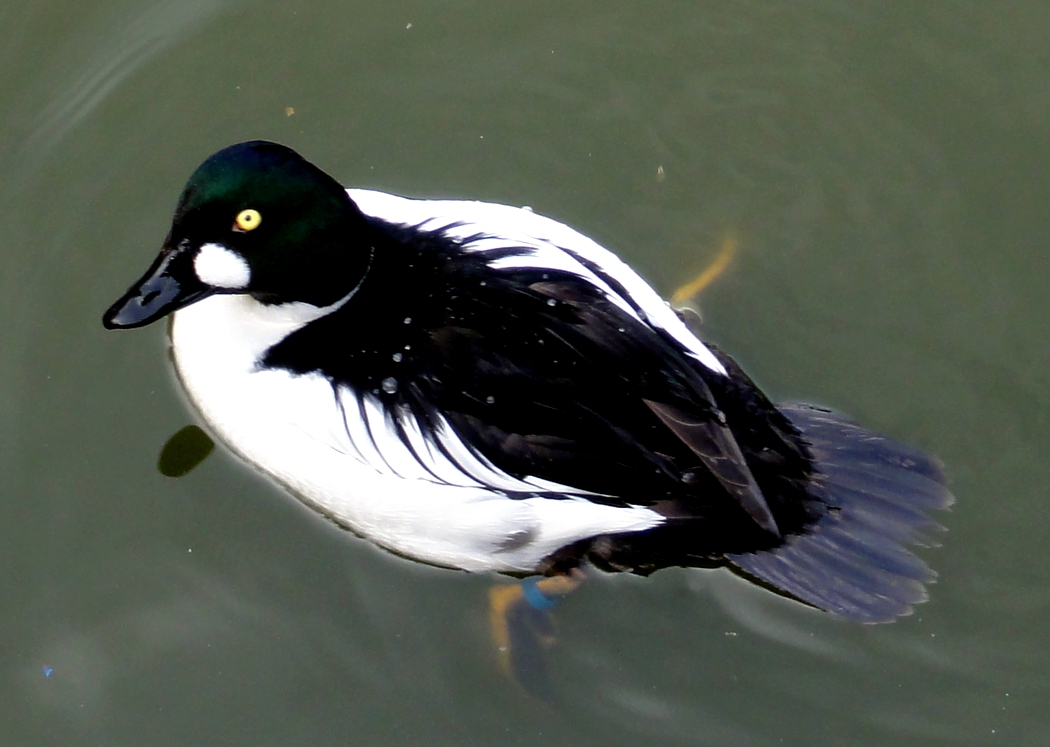
Common goldeneye(Bucephala clangula)
Phylum —chordata
Class — aves
Order — anseriformes
Family — anatidae
Genus –bucephala
Appearance
Adult males ranges from 45–51 cm (18–20 in) and weigh approximately 1,000 g (2.2 lb), while females range from 40–50 cm (16–20 in) and weigh approximately 800 g (1.8 lb). The common goldeneye has a wingspan of 30.3-32.7 in (77-83 cm).
The species is named for its golden-yellow eye. Adult males have a dark head with a greenish gloss and a circular white patch below the eye, a dark back and a white neck and belly. Adult females have a brown head and a mostly grey body. Their legs and feet are orange-yellow.
Habitat
Common goldeneyes are found throughout North America and Eurasia. They breed in higher latitudes, from Scotland, northern Europe, and Scandinavia across northern Eurasia to the Kamchatka Peninsula and throughout much of Canada from interior British Columbia to Newfoundland. They breed also in northernmost Michigan, northeastern Minnesota, northern Montana, and portions of northern New York, Vermont, and Maine.
Winter ranges include coastal North America from Alaska to Baja California, Newfoundland to Florida, and the northern Gulf of Mexico, throughout inland United States except for portions of Texas, the southeast, and Arizona, and into the Sierra Madre range of Mexico and northernmost coastal Mexico. In Eurasia they are found in coastal waters from Scandinavia to the Mediterranean, Black, and Caspian Seas and from Kamchatka to Japan.
Behavior
Common goldeneye populations migrate between their summer, breeding ranges and wintering grounds. They are often one of the last ducks to leave their summer grounds and will winter as far north as is possible in ice-free areas. Northward migrations towards breeding ranges begins in February in North America. Southward migration can begin as early as July, some populations begin migrating south as late as October. They generally migrate in small flocks of 4 to 40 individuals but will gather with other groups into large flocks at stopover areas.
Common goldeneyes spend most of their time on the water. They only walk when moving broods from the nest to the water or overland to other lakes. They can fly up to 72 km per hour with 9 wingbeats per second. Common goldeneyes are excellent swimmers and divers, they typically forage in small groups, diving synchronously to search for prey.
Diet
Common goldeneyes are diving birds that forage underwater. Year-round, about 32% of their prey is crustaceans, 28% is aquatic insects and 10% is mollusks. Insects are the predominant prey while nesting and crustaceans are the predominant prey during migration and winter. Locally, fish eggs and aquatic plants can be important foods.
Reproduction
These birds nest in cavities in large trees, where they return year after year, though they will readily use nest boxes as well. Natural tree cavities chosen for nest sites include those made by broken limbs and those made by large woodpeckers, specifically pileated woodpeckers or black woodpeckers.
Average egg size is a breadth of 42.6–44.0 mm (1.68–1.73 in), a length of 58.1–60.6 mm (2.29–2.39 in) and a weight of 61.2–66.6 g (2.16–2.35 oz). The incubation period ranges from 28 to 32 days. The female does all the incubating and is abandoned by the male about 1 to 2 weeks into incubation. The young remain in the nest for about 24–36 hours. The young are capable of flight at 55–65 days of age.
In captivity
Males can live to 11 years and females to 12 years.
These birds need a deep pool, but the best option is a reservoir (pond).
Common goldeneyes eat plant food: algae and their roots, various rhizomes of submerged cereals and grains, as well as their seeds.
The diet of these birds should include mollusks, snails, nymphs, earthworms and leeches. Protein-rich food is important for birds during the reproduction season. During feeding, adult females eat almost only organic food.
 Russian
Russian
 English
English
























